trailer CADILLAC DEVILLE 1993 7.G Owners Manual
[x] Cancel search | Manufacturer: CADILLAC, Model Year: 1993, Model line: DEVILLE, Model: CADILLAC DEVILLE 1993 7.GPages: 406, PDF Size: 20.78 MB
Page 92 of 406
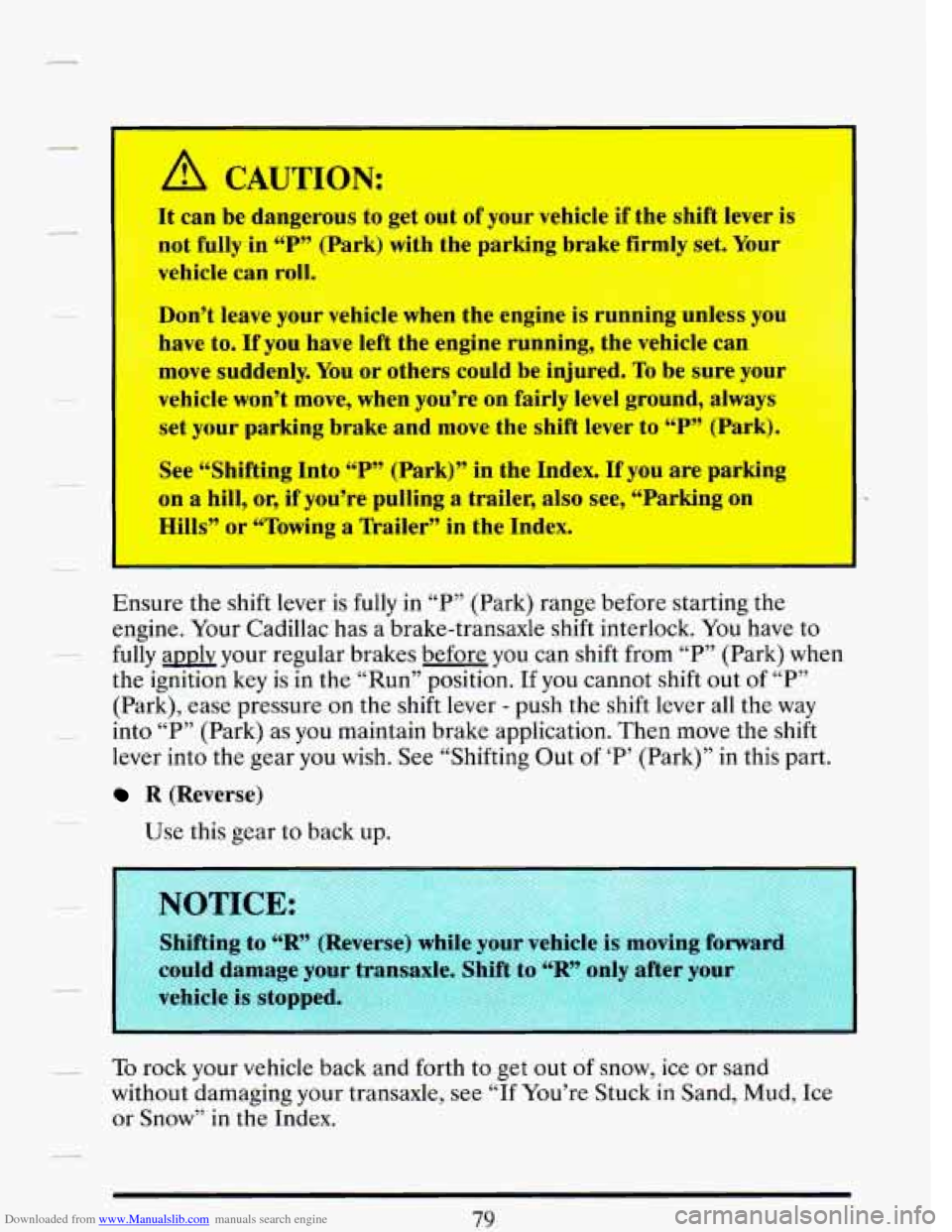
Downloaded from www.Manualslib.com manuals search engine - I
’
A CAUTION:
It can be dangerous to get out of ---ur vehicle if the shift lever is
not fully in
“P” (Park) with the parking brake firmly set. Your
vehicle can roll.
s-4 W$&I
Don’t leave your vehicle when the engine is running unless y
have to. If you have left the engine running, the vehicle can
move suddenly.
You or others could be injured. To be sure yo
vehicle won’t move, when you’re
on fairly level ground, always
set your parking brake and move the shift lever to
“P” (Park).
See “Shifting Into “P” (Park)” in the Index. If you are parking
on
a hill, or, if you’re pulling a trailer, also see, “Parking on
Hills” or “Towing
a nailer” in the Index.
Ensure the shift lever is fully in
“P” (Park) range before starting the
engine. Your Cadillac has a brake-transaxle shift interlock.
You have to
fully amlv your regular brakes before you can shift from “P” (Park) when
the ignition key is in the “Run” position.
If you cannot shift out of “P”
(Park), ease pressure on the shift lever
- push the shift lever all the way
into
“P” (Park) as you maintain brake application. Then move the shift
lever into the gear you wish. See “Shifting Out
of ‘P’ (Park)” in this part.
R (Reverse)
Use this gear to bacK
up.
hifting to “R” (Reverse) while your vehicle is m
ould damage your t
To rock your vehicle back and forth to get out of snow, ice or sand
without damaging your transaxle, see “If You’re Stuck
in Sand, Mud, Ice
or Snow” in the Index.
79
Page 94 of 406
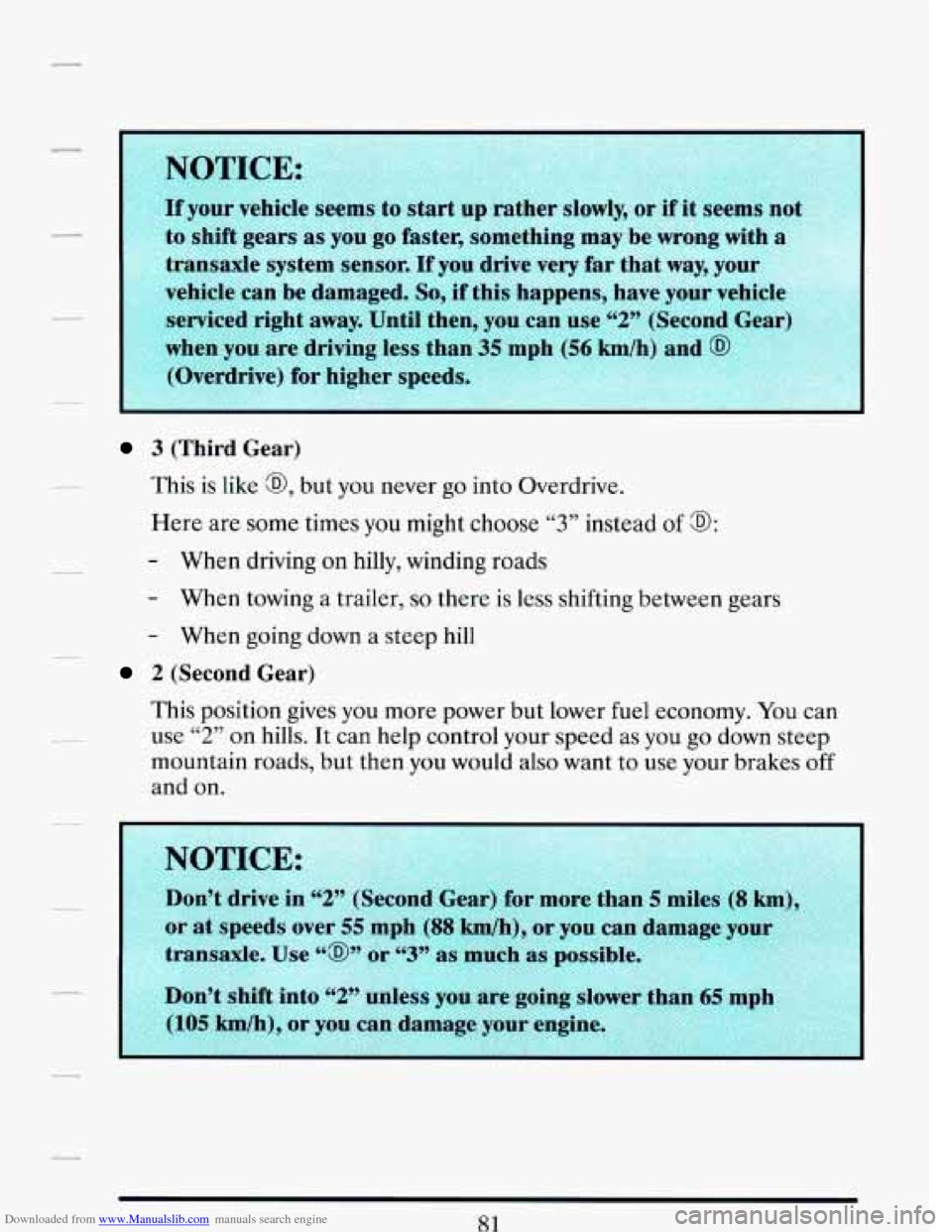
Downloaded from www.Manualslib.com manuals search engine 3 (Third Gear)
This is like a, but you never go into Overdrive.
Here are some times you might choose
“3” instead of a:
- When driving on hilly, winding roads
- When towing a trailer, so there is less shifting between gears
- When going down a steep hill
2 (Second Gear)
This position gives you more power but lower fuel economy. You can
use
2 on hills. It can help control your speed as you go down steep
mountain roads, but then you would also want to use your brakes off
and on. (6 77
81
Page 97 of 406
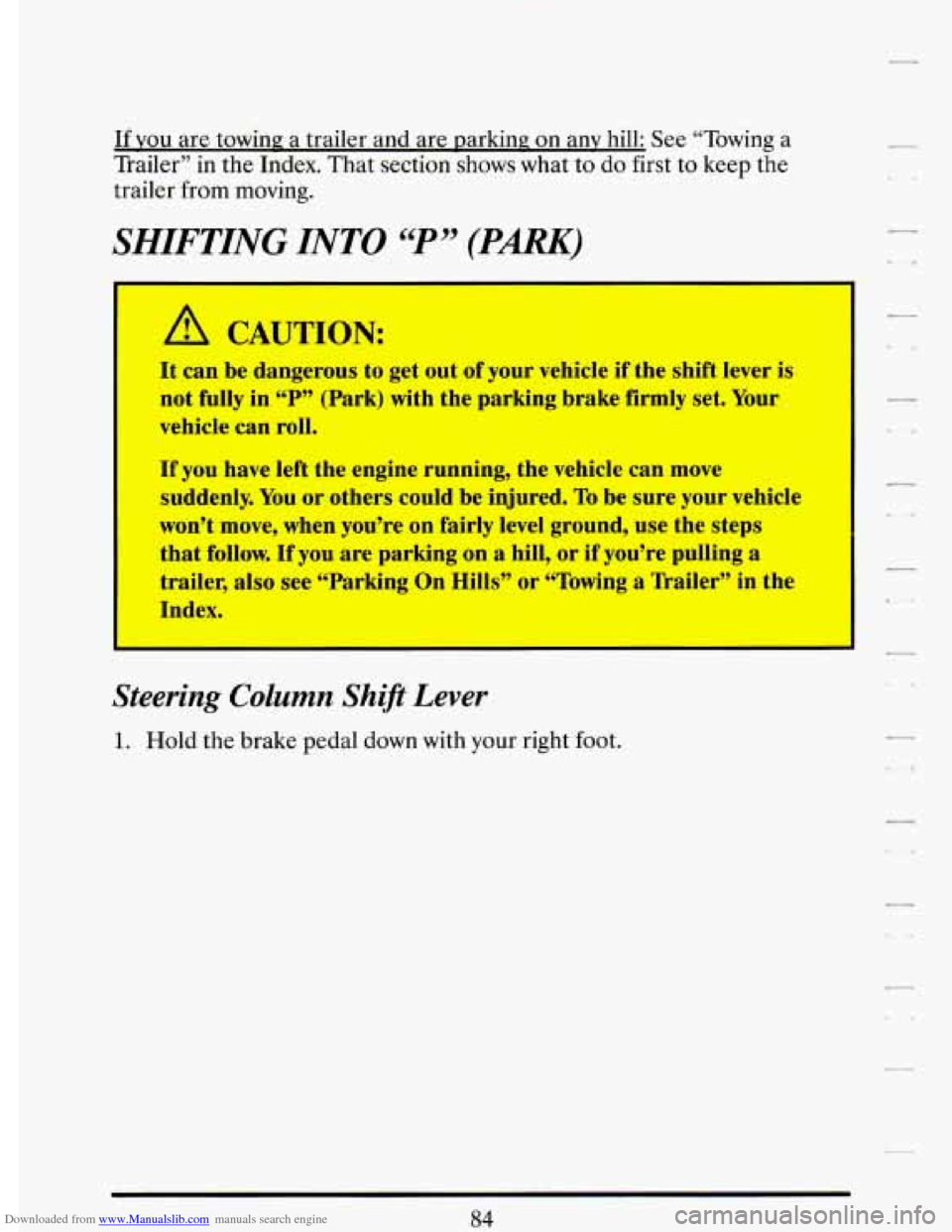
Downloaded from www.Manualslib.com manuals search engine If YOU are towinn a trailer and are parking; on any hill: See “Towing a
Trailer” in the Index. That section
shows what to do first to keep the
trailer from moving.
SHIFTING INTO “P” (PARK)
I A CAUTION:
I It can be dangerous to get out of your vehicle if the shift lever is
not fully in
“P” (Park) with the parking brake firmly set. Your
vehicle can roll.
If you have left the engine running, the vehicle can move
suddenly. You or others could be injured. To be sure your vehicle
won’t move, when you’re on fairly level ground, use the steps
that follow.
If you are parking on a hill, or if you’re pulling a
trailer, also see “Parking On Hills” or “Towing a Trailer” in the
Index.
I
I
Steering Column Shi! Lever
1. Hold the brake pedal down with your right foot.
7
b.
84
Page 102 of 406
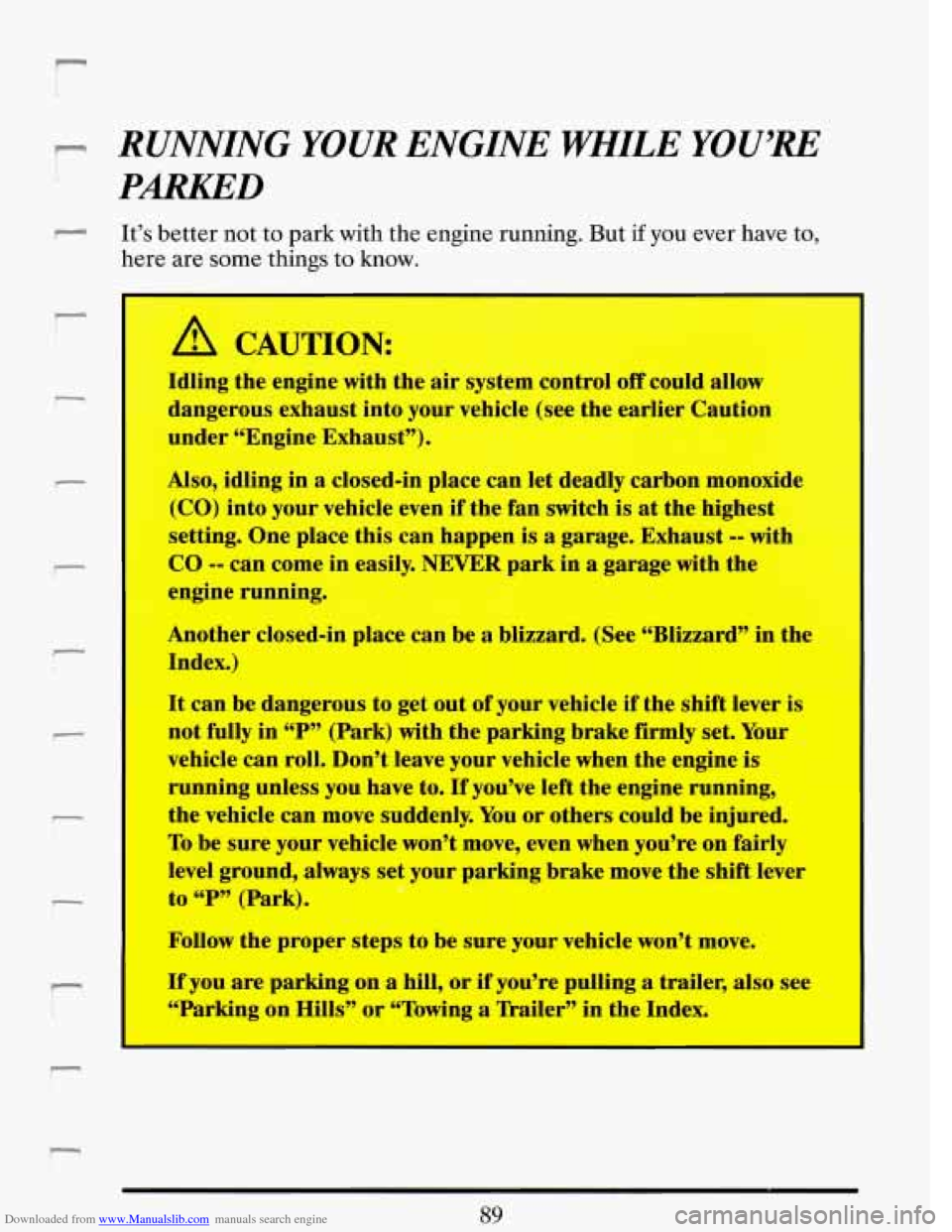
Downloaded from www.Manualslib.com manuals search engine m RUNNING YOUR ENGINE IZIiWLE YOUfRE I
PARKED
r It’s better not to park with the engine running. But if you ever have to,
here are some things to know.
I
F- I
A CAUTION:
Idling the engine with the air system control off could allow
dangerous exhaust into your vehicle (see the earlier Caution
under “Engine Exhaust”).
Also, idling in a closed-in place can let deadly carbon monoxide
(CO) into your vehicle even if the fan switch is
at the highest
setting. One place this can happen
is a garage. Exhaust -- with
CO -- can come in easily. NEVER park in a garage with the
engine running.
Another closed-in place can be a blizzard. (See “Blizzard” in the
Index.)
It can be dangerous to get out of your vehicle if the shift lever is
not fully in
“P” (Park) with the parking brake firmly set. Your
vehicle can roll. Don’t leave your vehicle when the engine is
running unless you have to.
If you’ve left the engine running,
the vehicle can move suddenly. You
or others could be injured.
To be sure your vehicle won’t move, even when you’re on fairly
level ground, always set your parking brake move the shift lever
to
“P” (Park).
Follow the proper steps to be sure your vehicle won’t move.
If you are parking on
a hill, or if you’re pulling a trailer, also see
“Parking on Hills” or “Towing
a lkailer” in the Index.
f
89
Page 230 of 406
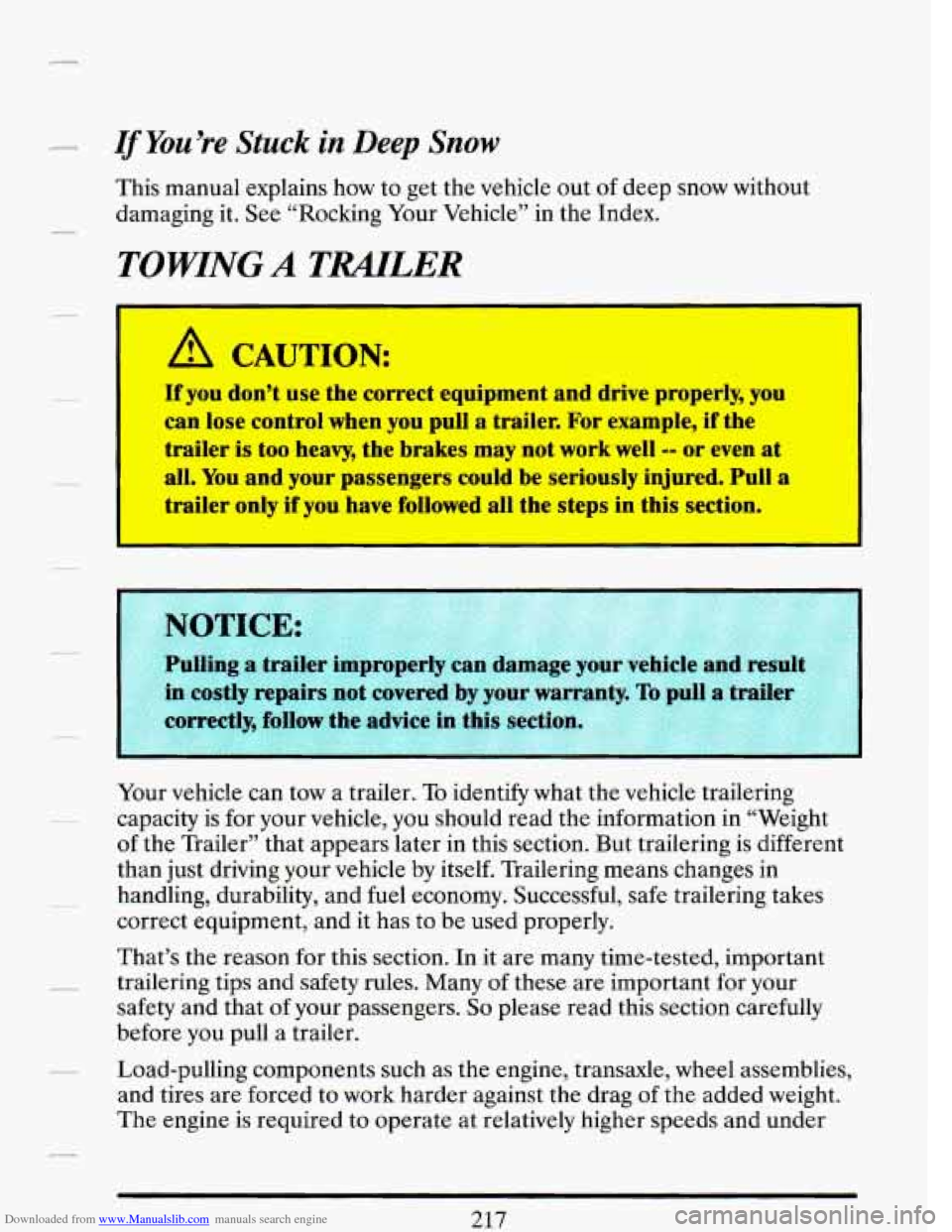
Downloaded from www.Manualslib.com manuals search engine If You’re Stuck in Deep Snow
This manual explains how to get the vehicle out of deep snow without
damaging it. See “Rocking Your Vehicle” in the Index.
TOWING A TWLER
I
‘ A CAUTION:
If you don’t use the correct equipment and drive properly, you
can lose control when you pull
a trailer. For example, if the
trailer
is too heavy, the brakes may not work well -- or even at
all. You and your passengers could be seriously injured. Pull a
trailer only if you have followed all the steps in this section.
Your vehicle can tow a trailer.
To identify what the vehicle trailering
capacity is for your vehicle, you should read the information in “Weight
of the Trailer” that appears later in this section. But trailering is different
than just driving your vehicle by itself. Trailering means changes in
handling, durability, and fuel economy. Successful, safe trailering takes
correct equipment, and it has to be used properly.
That’s the reason for this section. In
it are many time-tested, important
trailering tips and safety rules. Many of these are important for your
safety and that
of your passengers. So please read this section carefully
before you pull a trailer.
Load-pulling components such as the engine, transaxle, wheel assemblies,
and tires are forced to work harder against the drag of the added weight.
The engine is required
to operate at relatively higher speeds and under
217
Page 231 of 406
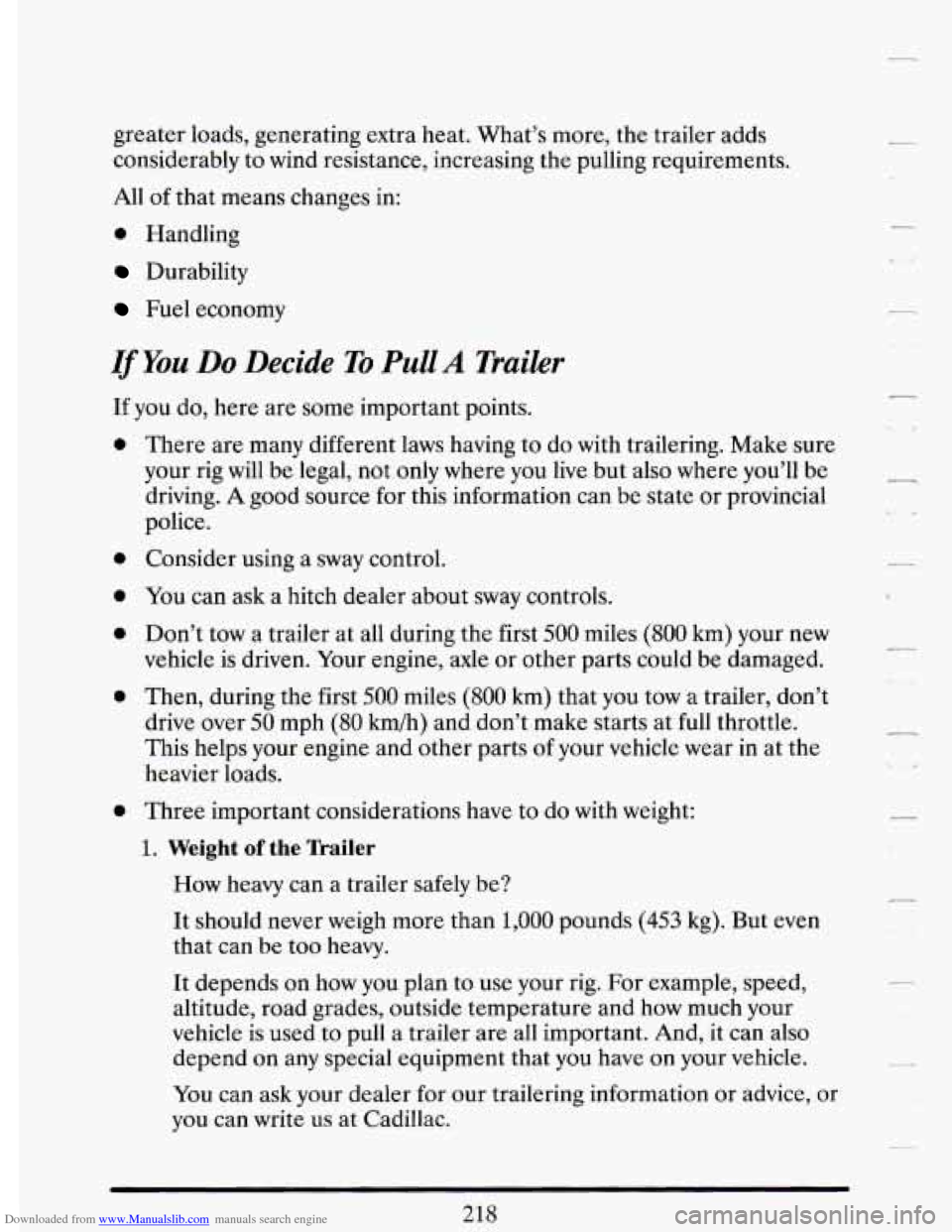
Downloaded from www.Manualslib.com manuals search engine greater loads, generating extra heat. What’s more, the trailer adds
considerably to wind resistance, increasing the pulling requirements.
All of that means changes in:
0 Handling
Durability
Fuel economy
If You Do Decide To Pull A Trailer
If you do, here are some important points.
0
0
0
0
0
0
There are many different laws having to do with trailering. Make sure
your rig will be legal, not only where you live but also where you’ll be
driving.
A good source for this information can be state or provincial
police.
Consider using a sway control.
You can ask a hitch dealer about sway controls.
Don’t tow a trailer at all during the first
500 miles (800 km) your new
vehicle
is driven. Your engine, axle or other parts could be damaged.
Then, during the first
500 miles (800 km) that you tow a trailer, don’t
drive over
50 mph (80 km/h) and don’t make starts at full throttle.
This helps your engine and other parts
of your vehicle wear in at the
heavier loads.
Three important considerations have to do with weight:
1. Weight of the nailer
How heavy can a trailer safely be?
It should never weigh more than
1,000 pounds (453 kg). But even
that can be too heavy.
It depends on how you plan to use your rig. For example, speed,
altitude, road grades, outside temperature and how much your
vehicle is used to pull a trailer are all important. And, it can also
depend on any special equipment that you have
on your vehicle.
You can ask your dealer for our trailering information or advice, or
you can write us at Cadillac.
I,
Page 232 of 406
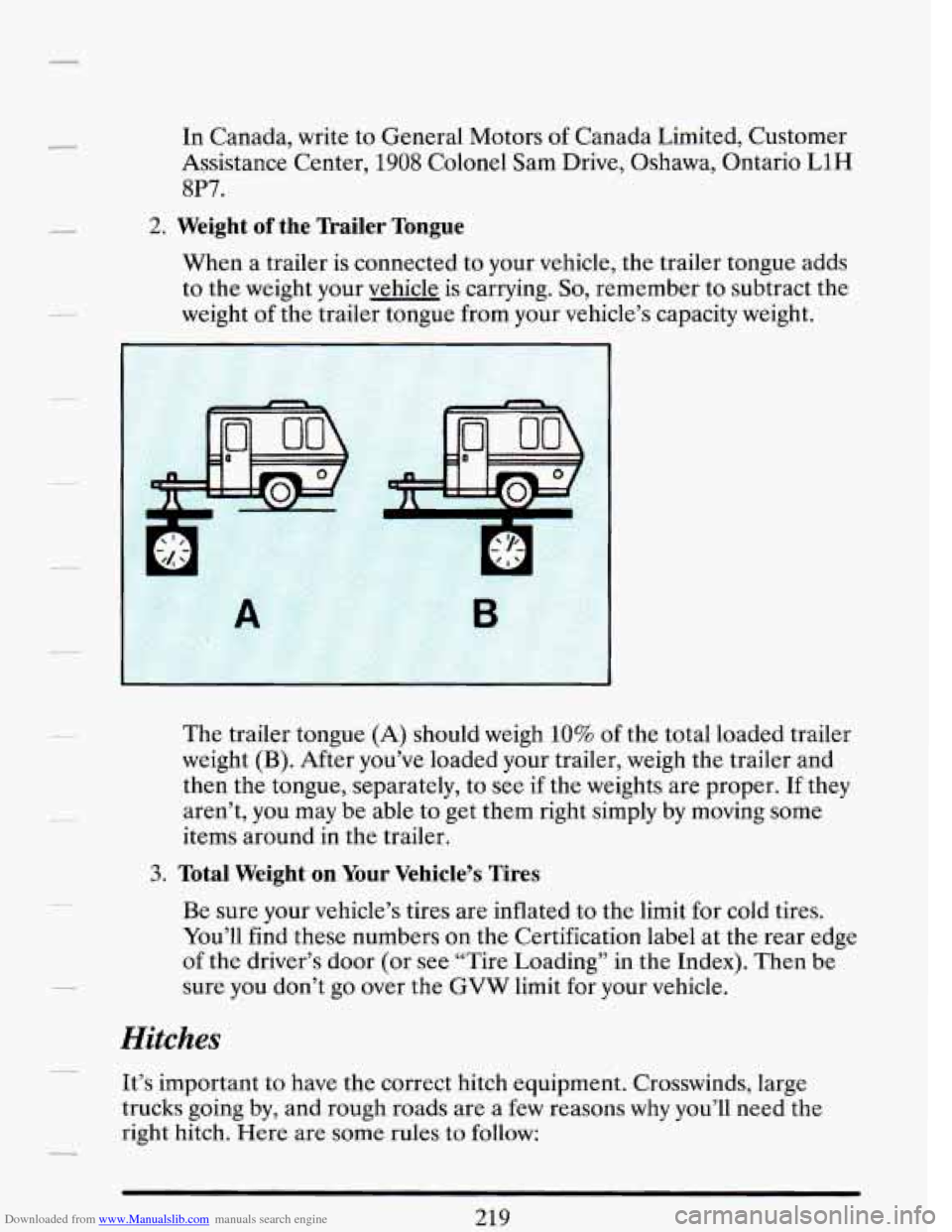
Downloaded from www.Manualslib.com manuals search engine In Canada, write to General Motors of Canada Limited, Customer
Assistance Center,
1908 Colonel Sam Drive, Oshawa, Ontario L1H
8P7.
2. Weight of the Trailer Tongue
When a trailer is connected to your vehicle, the trailer tongue adds
to the weight your vehicle is carrying.
So, remember to subtract the
weight
of the trailer tongue from your vehicle’s capacity weight.
The trailer tongue (A) should weigh
10% of the total loaded trailer
weight
(B). After you’ve loaded your trailer, weigh the trailer and
then the tongue, separately, to see if the weights are proper. If they
aren’t, you may be able to get them right simply by moving some
items around in the trailer.
3. Total Weight on Your Vehicle’s Tires
Be sure your vehicle’s tires are inflated to the limit for cold tires.
You’ll find these numbers
on the Certification label at the rear edge
of the driver’s door (or see “Tire Loading” in the Index). Then be
sure you don’t go over the
GVW limit for your vehicle.
Hitches
1
It’s important to have the correct hitch equipment. Crosswinds, large
trucks going by, and rough roads are a
few reasons why you’ll need the
right hitch. Here are some rules to
follow:
219
Page 233 of 406
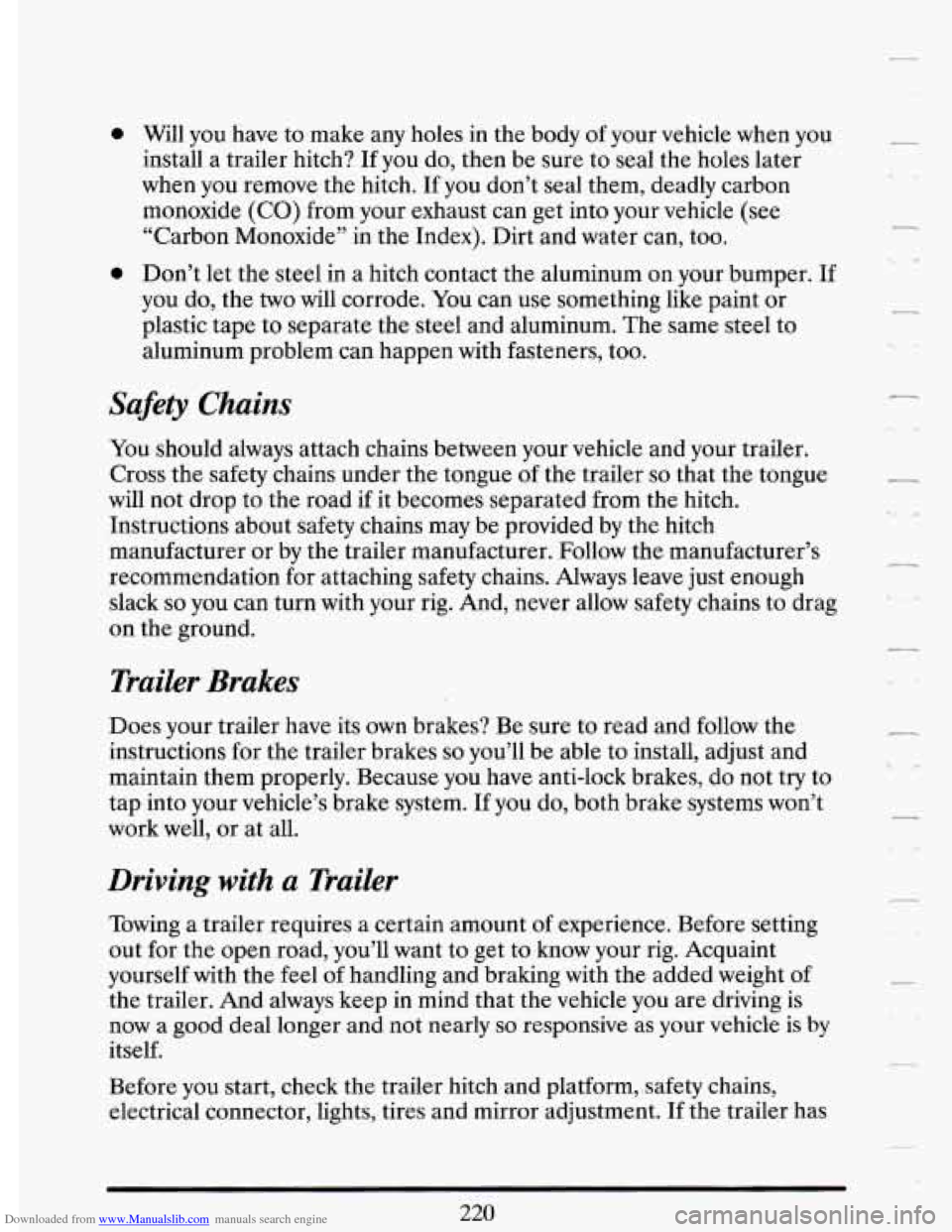
Downloaded from www.Manualslib.com manuals search engine e Will you have to make any holes in the body of your vehicle when you
install a trailer hitch? If you do, then be sure to seal the holes later
when you remove the hitch.
If you don’t seal them, deadly carbon
monoxide
(CO) from your exhaust can get into your vehicle (see
“Carbon Monoxide’’ in the Index). Dirt and water can, too.
e Don’t let the steel in a hitch contact the aluminum on your bumper. If
you do, the two will corrode. You can use something like paint or
plastic tape to separate the steel and aluminum. The same steel to
aluminum problem can happen with fasteners, too.
Safety Chains
You should always attach chains between your vehicle and your trailer.
Cross the safety chains under the tongue
of the trailer so that the tongue
will not drop to the road if it becomes separated from the hitch.
Instructions about safety chains may be provided by the hitch
manufacturer or by the trailer manufacturer. Follow the manufacturer’s
recommendation
for attaching safety chains. Always leave just enough
slack
so you can turn with your rig. And, never allow safety chains to drag
on the ground.
Trailer Brakes
Does your trailer have its own brakes? Be sure to read and follow the
instructions for the trailer brakes
so you’ll be able to install, adjust and
maintain them properly. Because you have anti-lock brakes, do not try to
tap into your vehicle’s brake system.
If you do, both brake systems won’t
work well,
or at all.
Driving with a Trailer
Towing a trailer requires a certain amount of experience. Before setting
out for the open road,’you’ll want to get to know your rig. Acquaint
yourself with the feel
of handling and braking with the added weight of
the trailer. And always keep in mind that the vehicle you are driving is
now
a good deal longer and not nearly so responsive as your vehicle is by
itself.
Before you start, check the trailer hitch and platform, safety chains,
electrical connector, lights, tires and mirror adjustment. If the trailer has
L
.-.
Page 234 of 406
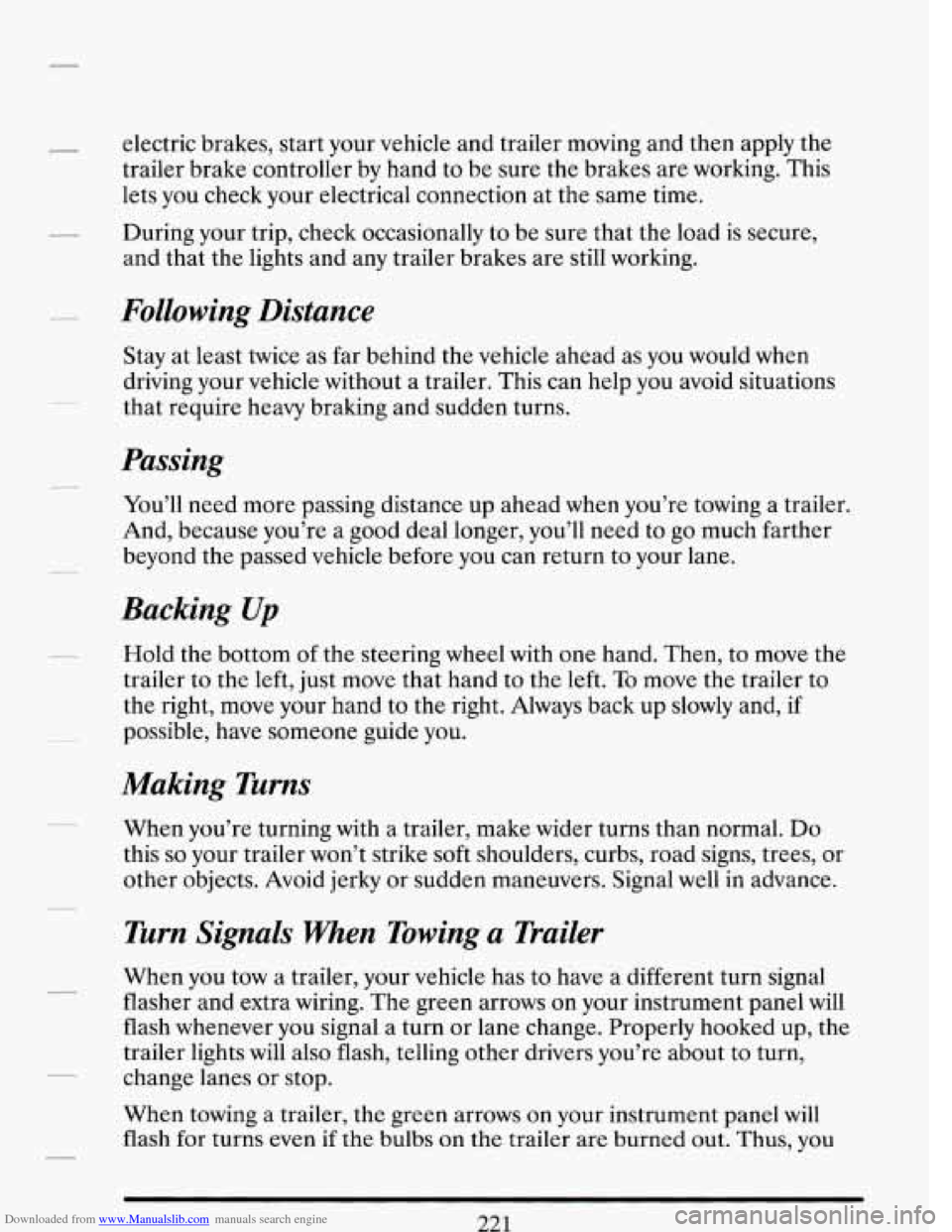
Downloaded from www.Manualslib.com manuals search engine electric brakes, start your vehicle and trailer moving and then apply the
trailer brake controller by hand to be sure the brakes are working. This
lets you check your electrical connection at the same time.
During your trip, check occasionally to be sure that the load is secure,
and that the lights and any trailer brakes are still working.
Following Distance
Stay at least twice as far behind the vehicle ahead as you would when
driving your vehicle without
a trailer. This can help you avoid situations
that require heavy braking and sudden turns.
Passing
You’ll need more passing distance up ahead when you’re towing a trailer.
And, because you’re a good deal longer, you’ll need to go much farther
beyond the passed vehicle before you can return to your lane.
Backing Up
Hold the bottom of the steering wheel with one hand. Then, to move the
trailer to the left, just move that hand to the left.
To move the trailer to
th.e right, move your hand to the right. Always back up slowly and,
if
possible, have someone guide you.
Making Turns
When you’re turning with a trailer, make wider turns than normal. Do
this so your trailer won’t strike soft shoulders, curbs, road signs, trees, or
other objects. Avoid jerky
or sudden maneuvers. Signal well in advance.
Turn Signals When Towing a Trailer
When you tow a trailer, your vehicle has to have a different turn signal
flasher and extra wiring. The green arrows on your instrument panel
will
flash whenever you signal a turn or lane change. Properly hooked up, the
trailer lights will also flash, telling other drivers you’re about to turn,
change lanes or stop.
When towing
a trailer, the green arrows on your instrument panel will
flash for turns even
if the bulbs on the trailer are burned out. Thus, you
221
Page 235 of 406
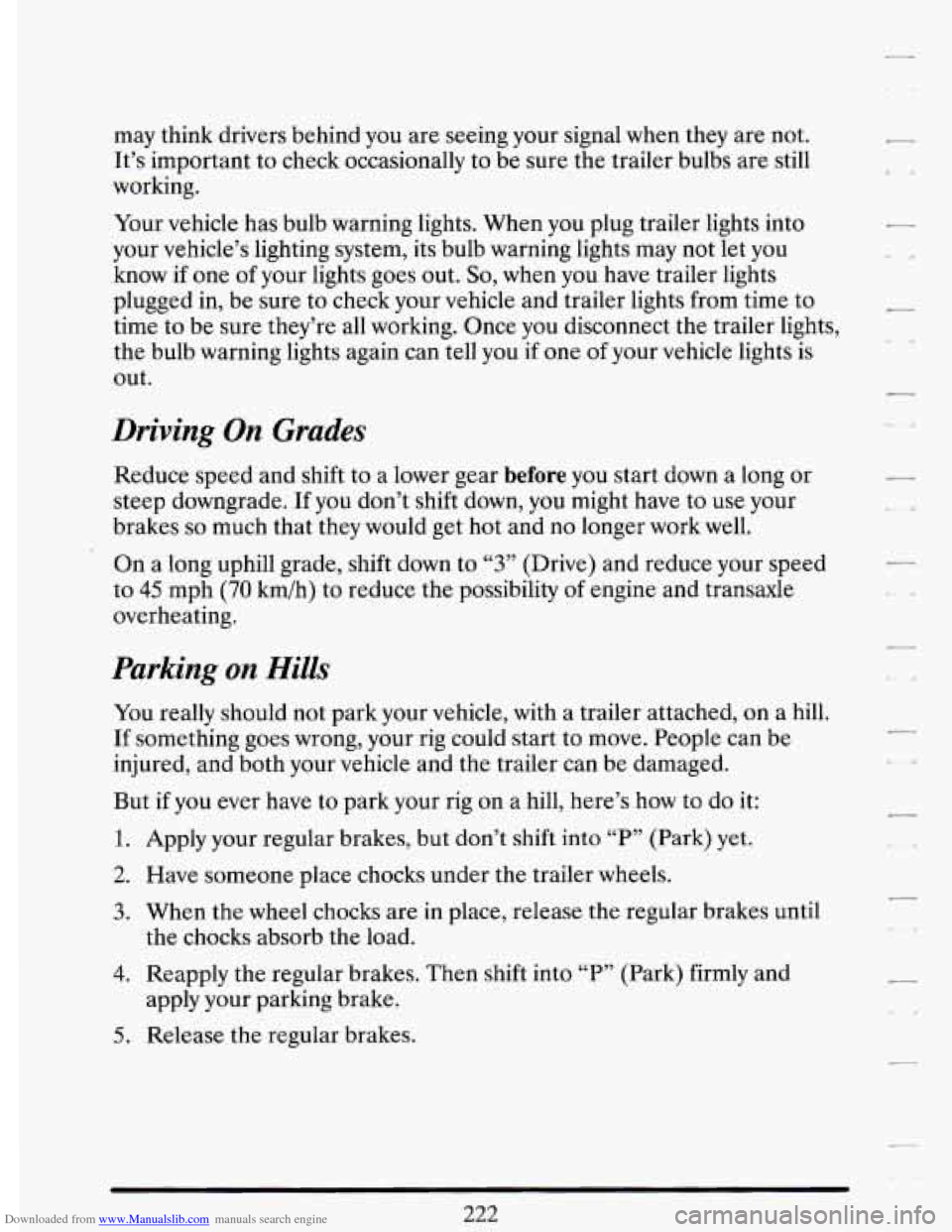
Downloaded from www.Manualslib.com manuals search engine may think drivers behind you are seeing your signal when they are not.
It’s important to check occasionally to be sure the trailer bulbs are still
working.
Your vehicle has bulb warning lights. When you plug trailer lights into
your vehicle’s lighting system, its bulb warning lights may not let you
know if one
of your lights goes out. So, when you have trailer lights
plugged in, be sure to check your vehicle and trailer lights
from time to
time to be sure they’re all working. Once you disconnect the trailer lights,
the bulb warning lights again can tell you if one of your vehicle lights is
out.
Driving On Grades
Reduce speed and shift to a lower gear before you start down a long or
steep downgrade.
If you don’t shift down, you might have to use your
brakes
so much that they would get hot and no longer work well.
On a long uphill grade, shift down to “3” (Drive) and reduce your speed
to
45 mph (70 km/h) to reduce the possibility of engine and transaxle
overheating.
Parking on Hills
You really should not park your vehicle, with a trailer attached, on a hill.
If something goes wrong, your rig could start to move. People can be
injured, and both your vehicle and the trailer can be damaged.
But if you ever have to park your rig on a hill, here’s how to do it:
1. Apply your regular brakes, but don’t shift into “P” (Park) yet.
2. Have someone place chocks under the trailer wheels.
3. When the wheel chocks are in place, release the regular brakes until
the chocks absorb the load.
4. Reapply the regular brakes. Then shift into “P” (Park) firmly and
apply your parking brake.
5. Release the regular brakes.
222